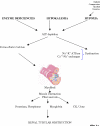Bench-to-bedside review: Rhabdomyolysis -- an overview for clinicians
- PMID: 15774072
- PMCID: PMC1175909
- DOI: 10.1186/cc2978
Bench-to-bedside review: Rhabdomyolysis -- an overview for clinicians
Abstract
Rhabdomyolysis ranges from an asymptomatic illness with elevation in the creatine kinase level to a life-threatening condition associated with extreme elevations in creatine kinase, electrolyte imbalances, acute renal failure and disseminated intravascular coagulation. Muscular trauma is the most common cause of rhabdomyolysis. Less common causes include muscle enzyme deficiencies, electrolyte abnormalities, infectious causes, drugs, toxins and endocrinopathies. Weakness, myalgia and tea-colored urine are the main clinical manifestations. The most sensitive laboratory finding of muscle injury is an elevated plasma creatine kinase level. The management of patients with rhabdomyolysis includes early vigorous hydration.
Figures



References
-
- Farmer J. Rhabdomyolysis. In: Civetta J, Taylor R, Kirby R, editor. In Critical Care. 2. Philadephia, PA: Lippincott; 1997. pp. 1785–1791.
-
- Book of Numbers . The Bible The New English Bible, 1970 Joint Comitee on the New Translation of the Bible. Vol. 11. New York: Cambridge University Press; pp. 31–35.
-
- Rizzi D, Basile C, Di Maggio A. Clinical spectrum of accidental hemlock poisoning: neurologic manifestations, rhabdomyolysis and acute tubular necrosis. Nephrol Dial Transplant. 1991;6:939–943. - PubMed
Publication types
MeSH terms
Substances
LinkOut - more resources
Full Text Sources
Other Literature Sources

